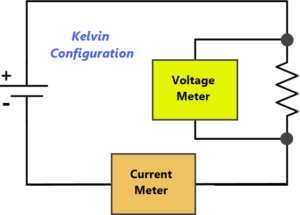How do you accurately measure power consumption when the leads of your multimeter add resistance to your measurement? How do you accurately measure the resistance of a device that’s low, (e.g., less than 10 ohms) when the leads of your multimeter add resistance?
One way to get a more accurate reading is to use the Kelvin measurement configuration, which is used in power analyzer tools. However, power analyzer tools are even more accurate, since they take a lot of readings and average out fluctuations. The Kelvin measurement configuration is a 4-terminal connection that measures the voltage drop across the resistor, which is proportional to the current flowing through the resistor, and the second set of leads are used for an additional 2 terminal points at the same nodes. The leads should be placed as close across the resistor as possible (especially on low-value resistors). Ohm’s Law (V=IR) shows us the current (I=V/R) and its dependence upon the resistance and the voltage reading.
| Test Method | Resistor Value that’s being Tested | Lead Path Resistance | Error introduced by Leads |
| 2-wire | 1 ohm | 10 milliohms | 2% |
| 4-wire | 1 ohm | 20 milliohms | <0.1% |
Table 1: Example measurement errors at 2 watts. Each test lead/probe can introduce anywhere from 10milliohms to one full ohm or more of resistance to the resistor value that you are testing with a 2-wire multimeter.[i]
Most digital multimeters implement the two-wire method, so the Kelvin configuration, a 4-wire method, is best when you have low-value resistance to measurement. The 4-wire Kelvin method mitigates the resistance introduced by the test leads themselves, which is part of the measurement reading in the 2-wire method. The Kelvin method forces test current from the meter through the test resistance with one set of test leads (2 wires) while the voltage is measured through the other 2 leads. A tiny bit of current will pass through the leads but is negligible. According to Keithley, that negligible amount is on the order of 10-14 amps (100 Pico amps). An ammeter and a digital multimeter are all that is needed to measure low resistance values accurately.
Since each test lead/probe can introduce anywhere from 10milliohms to one full ohm or more of resistance to the resistor value that you are testing with a 2-wire multimeter, the four-wire (Kelvin) method may help to avoid results that can set you off course in troubleshooting. For very low-value resistances, don’t forget to place your test leads as close as possible to the resistor under test to avoid adding any additional error due to wire or trace resistance.

For a full article explaining the above in detail (written as an application note) see RCD Components’ Application Note R-31, “2-Terminal vs. 4-Terminal Resistors.” You can download it as a PDF here. Keithley (a Tektronix company) has an excellent application note as well: Overview of Two-wire and Four-wire (Kelvin) Resistance Measurements
[i] Table 1 is adapted from Keithley’s Overview of Two-wire and Four-wire (Kelvin) Resistance Measurements, which has a typographical error that has been fixed in the Table 1 in this article.
Leave a Reply